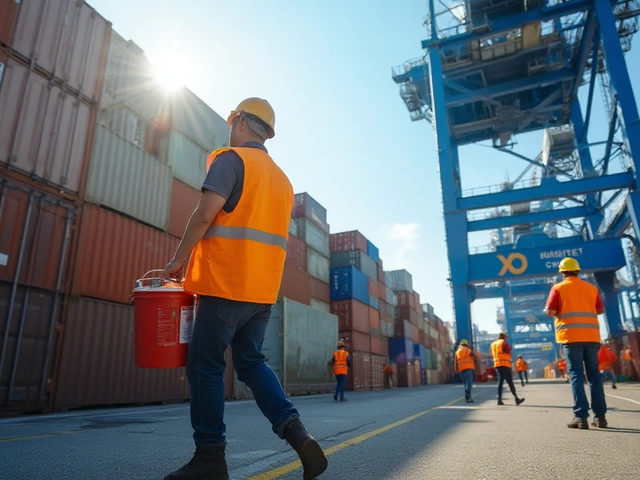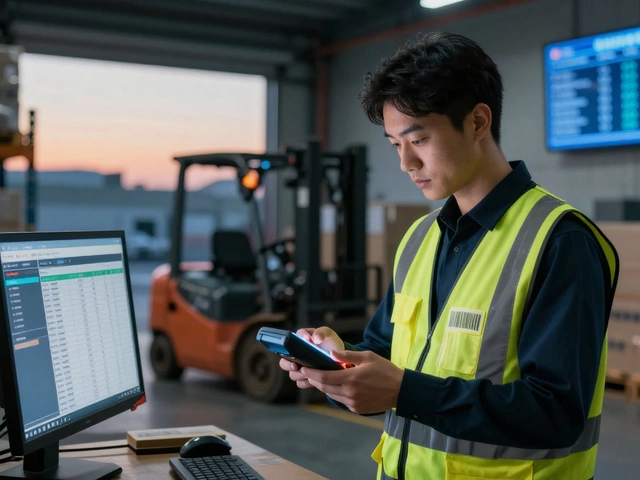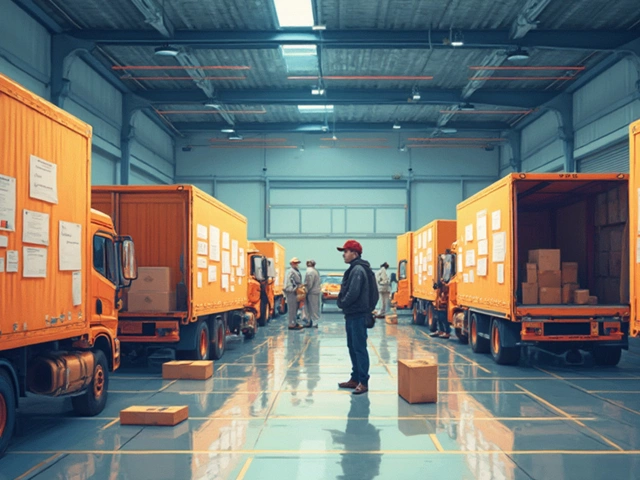Waiting for a package should be easy, right? You shop online, click a button, and BAM—the promise of something cool landing outside your door. But behind that magic moment is a wild maze of logistics, timing, and a lot of moving parts that most people never see. If you've ever wondered what actually goes on after you place an order, e-commerce delivery is the invisible engine making it all happen. It’s not just about getting packages from point A to B—it's a whole world of tech, competition, and sometimes, chaos.
What Really Happens After You Place an Order?
Shopping online seems simple, but each purchase kicks off a surprisingly complex chain of events. First, your order zips to a warehouse or a fulfillment center—this could be a massive building packed with shelves stacked to the ceiling or a compact urban facility close to the city core. Automation runs the show in most modern centers; robotic arms and conveyor belts hustle packages from storage to packing stations, with employees (yes, actual humans) handling delicate or odd-shaped items robots can’t manage. Back in 2021, Amazon said their robots handled about 70% of all package movement in U.S. centers. That number's only grown since.
Once your item is found in inventory, it gets picked, scanned, and packed. Here’s a little tip: orders placed earlier in the day often get processed quicker than evening orders, simply because operations run full tilt from morning. The clock is ticking—most top e-commerce brands now promise same-day or next-day shipping in big cities. As soon as your package is packed and labeled, it’s sorted (sometimes moved by AI-driven systems) based on its destination, and then bundled for carriers like UPS, FedEx, DHL, or a regional delivery service.
What you might not know: some stores ship items directly from physical shops if you live nearby. This can slash delivery times, but it’s a mega challenge for inventory tracking. Other times, if you’re ordering from overseas, your item hits a customs checkpoint before moving on. International orders, especially from marketplaces like AliExpress, might share shipping with hundreds of others in giant consolidation centers before flying out.
The last leg is often the most unpredictable, sometimes called the "last mile". This is where your box moves from a local depot to your actual doorstep. City traffic, weather, holidays, or even a lazy delivery driver can all mess with the timeline. During the 2023 holiday season, for example, an estimated 7% of all e-commerce packages in the US arrived late, according to ShipMatrix. So, when that tracking email says “Out for delivery” but your package is nowhere in sight, now you have a sense of the possible holdup.
| Year | Global E-commerce Sales (USD) | Average Delivery Time (US) | Late Delivery Rate (%) |
|---|---|---|---|
| 2021 | 4.9 Trillion | 3.1 days | 9.2 |
| 2023 | 6.3 Trillion | 2.3 days | 7.0 |
| 2025 (Est.) | 7.8 Trillion | 1.9 days | 5.4 |
So, every time you check your tracking code, remember the choreography happening behind the scenes just to get your shopping spree to your door.
The Different Types of E-commerce Delivery Services
Not all deliveries are created equal. Shopping for a TV, groceries, shoes, or luxury skincare? Each one might follow a different delivery playbook. The oldest style is standard shipping—think three to seven business days with your order bundled up with a heap of others and moved via trucks criss-crossing the country. It’s reliable, especially for items that aren’t urgent, but not always the fastest game in town.
Express and next-day deliveries have totally moved the goalposts. With companies like Amazon, Walmart, or Target offering same-day and overnight shipping, expectations for quick delivery went way up. It’s not just convenience—people actually abandon online shopping carts 40% of the time if they see slow or expensive delivery, according to a study from Baymard Institute. In some cities, you can even score delivery in under one hour thanks to gig-economy services powered by apps like Instacart, DoorDash, Gopuff, and Uber.
There’s also the idea of “scheduled delivery.” This is perfect for items like furniture or appliances when you want a friendly heads-up before a sofa shows up on your porch. Some companies offer green or “eco-friendly” shipping options, using electric cars or bike couriers to cut their carbon footprint. Big retailers experiment with pick-up lockers and local collection points, so you can grab your package at 7-Eleven or a corner store at 11pm if that’s your thing.
Probably the wildest recent trend is autonomous delivery. Yes, robots and drones. In 2024, Walmart did over 10,000 drone deliveries in Texas alone—zipping medicine and snacks literally over people’s roofs to their backyards. It’s still early days, though, so don’t expect a robot on your street tomorrow.
- Standard Shipping: Cheapest, slower, often bundled in bigger shipments
- Express/Next-Day: Premium fee, lightning speed, usually for urgent orders
- Same-Day: Growing fast, relies on local warehouses and drivers
- Scheduled Delivery: Set a time, ideal for large or delicate goods
- Eco Options: Reduced emissions, sometimes slower, good for those carbon footprints
All these choices come with trade-offs: pay more, get faster or greener delivery and more precision with timing. Sometimes you don’t need the fastest shipping—just reliability and clear communication if there’s a hiccup.

Technology Powering the Package Race
Behind every smooth and speedy delivery is a mountain of technology. You’d hardly believe the amount of software, sensors, and data that make your online order happen. Giant logistics firms and e-commerce giants use AI to forecast demand so that what you want is always in stock nearby. Warehouse robots, like those from Kiva Systems (snapped up by Amazon), cut picking time in half. RFID tags help track inventory so nothing gets lost or double-sold—a pain that led to a $30B loss in U.S. retail stock-outs in 2023 alone.
Smart routing software means your package gets paired to the shortest, fastest, or cheapest route at every step. Carriers save on fuel and get your box to you faster. Ever notice how some brands nail delivery while others always lag? Half the battle is data. Companies like Shopify, ShipBob, and Flexe offer real-time dashboards so online sellers can see each package’s journey, reroute stalled orders, and even ping customers when something goes wrong.
Speaking of tracking, those updates you get (“Your order has shipped!”) rely on barcode scans at every handoff. It’s almost like your package gets a passport stamp every time it changes hands. In urban areas, some startups now use live location updates, showing you a map with your actual driver en route, just like food delivery.
The cutting edge? Machine learning for predicting delivery hiccups before they happen—storm ahead, traffic jam, or a vehicle breakdown. in 2024, DHL rolled out AI tools that detect and reroute packages if delays are likely, leading to a 15% drop in late arrivals in their pilot regions.
One of the trickiest puzzles is reverse logistics—meaning, returns. In fashion e-commerce, nearly 30% of orders get sent back, often for free. Smart companies make returns painless (think pre-paid labels and drop-off bins everywhere) because a hassle-free return process means you’ll likely shop again.
- Warehouse automation: Speeds up picking and packing, lowers mistakes
- Real-time tracking: Keeps sellers and buyers in the loop
- AI routing: Finds smarter, faster paths for each shipment
- Data analytics: Spots peaks, bottlenecks, and customer hang-ups
- Reverse logistics tools: Make returns less painful for shoppers
Want a pro tip? If you’re ordering something vital, like birthday gifts or event outfits, always opt for companies that offer detailed, real-time tracking. It takes the anxiety out if things go sideways.
Tips for Stress-Free E-commerce Deliveries
If waiting for a delivery makes your hands twitchy or your doorbell is haunted by package delays, a few smart moves can save you a ton of hassle. Before ordering, double-check the estimated delivery window. Some stores bury the real shipping times in the fine print—look for promised dates instead of vague ranges like “Usually ships in 3-5 business days.” And if timing matters, pony up for express shipping. It’s worth it for time-sensitive stuff, especially during peak shopping seasons (anyone else remember the 2022 holiday meltdown?).
Tracking is your friend. Most sellers now email you a tracking number, and some even ping you if the schedule slips. Bookmark your carrier’s tracking page—sometimes it’s more up-to-date than the store’s app. If you’re not home much or worried about porch pirates, try having packages sent to a pickup locker, your office, or to a neighbor you trust. Porch theft is no joke—2024 stats say nearly 17% of Americans had a package swiped, some more than once!
If your order is late, don’t just stew—contact customer service right away. Many stores refund shipping fees for missed guaranteed dates (a nice bonus). Also, sign up for carrier services like FedEx Delivery Manager or UPS My Choice; these let you schedule drop-offs and get push notifications if there’s a snag.
If you run a small e-commerce shop, always give honest delivery windows and upload tracking numbers fast. Quick communication builds customer loyalty and saves you headaches down the line. Invest in shipping software or apps that automate most steps—a lifesaver during big shopping events or flash sales.
- Check real delivery dates, not just shipping speed descriptions
- Use tracking for every order—apps can alert you faster than email
- Consider pickup locations if theft or missed deliveries are a hassle
- Keep your contact info accurate; delivery drivers sometimes call if lost
- For businesses, transparency on delivery and returns makes or breaks reputation
So next time your favorite order materializes at your door, remember: what seems like effortless magic is actually a wild dance of tech, teamwork, and tons of little decisions happening at lightning pace behind the scenes. E-commerce delivery keeps evolving, and companies are racing to make the journey smoother for everyone—maybe your next package will even drop in by drone.





